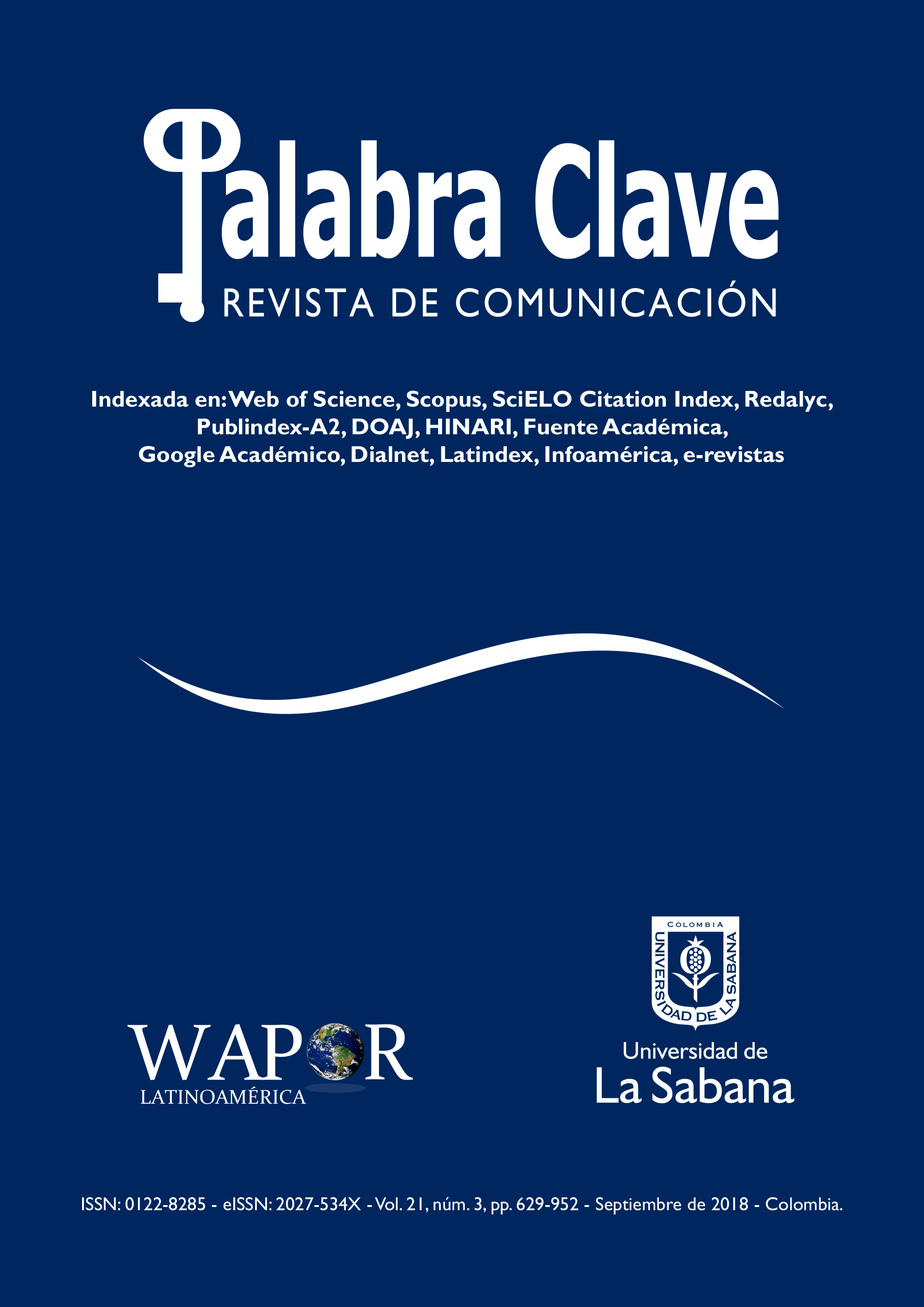Sharing Media and Electoral Preference on Twitter: Analysis of Public Opinion during the 2014 Elections in Brazil
Keywords:
Brazil, 2014 elections, social networks, public opinion, TwitterAbstract
This research analyzed a series of tweets published during the second round of the 2014 presidential elections in Brazil, in order to investigate the shared media and the electoral preference of citizens on Twitter. To that end, we developed a methodology and applied a manual analysis of content and sentiment to a sample of 1129 tweets (N = 1129) published at the time in order to identify which media were shared in each of the publications and the electoral preference between the two candidates expressed in the tweet. Our findings reinforce the idea that mainstream media is predominantly share don social media, but also that there is considerable presence (40%) of what we call “complementary media,” which offer more partybased content during the campaign. Furthermore, both “audiences” in the analysis shared the same proportion of mainstream and complementary media, which denotes a pattern to be tested in future studies.Downloads
References
Azevedo, F. (2010). Corrupção, mídia e escândalos midiáticos no Brasil. De-bate, 2(3), 14-19.
Brasil, Presidência da República. (2014). Pesquisa Brasileira de Mídia 2014. Secom. Recuperado em http://www.secom.gov.br/atuacao/pesquisa/lista-total-de-pesquisas/relatorio-final-pesquisa-brasileira-de-midia-2014.pdf
Brasil, Presidência da República. (2015). Pesquisa Brasileira de Mídia 2015. Secom. Recuperado em http://www.secom.gov.br/atuacao/pesquisa/lista-de-pesquisas-quantitativas-e-qualitativas-de-contratos-atuais/pesquisa-brasileira-de-midia-pbm-2015.pdf
Dewey, J. (2012[1922]). The Public and its Problems: An Essay in Political In-quiry. Pennsilvania: The Pennsilvania State University Press.
Dutta-Bergman, M. J. (2004). Complementary in Consumption of News Types Across Traditional and New Media. Journal of Broadcasting & Electronic Me-dia, 48(1), 41-60.
Foster, R. (2012). News Plurality In a Digital World. Reuters Institute for the Study of Journalism. Recuperado em http://reutersinstitute.politics.ox.ac.uk/sites/default/files/News%20Plurality%20in%20a%20Digital%20World_0.pdf
Gomes, W., Fernandes, B., Reis, L. e Silva, T. (2009). “Politics 2.0”: A campa-nha on-line de Barack Obama em 2008. Revista de Sociologia e Política 17(34), 29-43.
Gurevitch, M., Coleman, S. e Blumler, J. G. (2009). Political Communication: Old and New Relationships. Annals, AAPSS, vol. 625. doi: 10.1177/0002716209339345
Habermas, J. (1991). The Structural Transformation of the Public Sphere: An Inquiry Into a Category of Bourgeois Society. Cambridge, MA: MIT Press.
Ituassu, A. e Lifschitz, S. (2015) Temas e mídia em #Eleições2014: Twitter, opinião pública e comunicação política no contexto eleitoral brasileiro. E-Compós, 18(2), 1-19.
Ituassu, A., Capone, L., Parente, T. e Pecoraro, C. (2014). Internet, eleições e democracia: o uso das redes sociais digitais por Marcelo Freixo na campanha de 2012 para a Prefeitura do Rio de Janeiro. Compolítica, 4(2), 59-86.
doi: http://dx.doi.org/10.21878/compolitica.2014.4.2.152
Karppinen, K. (2009). Rethinking Media Pluralism and Communicative Abun-dance. McGannon Center Research Resources. Recuperado em
http://fordham.bepress.com/cgi/viewcontent.cgi?article=1008&context=mcgannon_research
Muñiz, C., Dader, J. L., Téllez, N. M. e Salazar, A. (2016). ¿Están los políticos políticamente comprometidos? Análisis del compromiso político 2.0 desarrol-lado por los candidatos a través de Facebook. Cuadernos.info, (39), 135-150. doi: 10.7764/cdi.39.970
Murta, F., Ituassu, A, Capone, L. e Rovere, R. L. (2017). Eleições e mídias so-ciais: interação e participação no Facebook durante a campanha para a Câ-mara dos Deputados em 2014. Revista Compolítica, 7(1), 47-72. doi: http://dx.doi.org/10.21878/compolitica.2017.1.1.275
Newman, N. (2011). Mainstream media and the distribution of news in the age of social discovery. Reuters Institute for the Study of Journalism. Recuperado em http://reutersinstitute.politics.ox.ac.uk/sites/default/files/Mainstream%20media%20and%20the%20distribution%20of%20news%20in%20the%20age%20of%20social%20discovery_0.pdf
Newman, N. e Levy, D. (2012). Digital News Report 2012. Reuters Institute for the Study of Journalism. Recuperado em http://reutersinstitute.politics.ox.ac.uk/sites/default/files/Digital%20News%20Report%202012.pdf
Newman, N., Levy, D. e Nielsen, K. (2015). Digital News Report 2015. Reuters Institute for the Study of Journalism, 2015. Recuperado em
http://reutersinstitute.politics.ox.ac.uk/publication/digital-news-report-2015
O’connor, B., Balasubramanyan, R., Routledge, B. e Smith, N. A. (2010). From Tweets to Polls: Linking Text Sentiment to Public Opinion Series. Proceedings of the Fourth International AAAI Conference on Webblogs and Social Media.
Oliveira, D. J. S., Bermejo, P. H. S. e Santos, P. A. (2016). Can social media review the preferences of voters? A comparison between sentiment analysis and traditional opinion polls. Journal of Information Technology & Politics. doi: 10.1080/19331681.2016.1214094
Pew Research Center. (2015). State of the News Media 2015. Pew Research Center. Recuperado em http://www.journalism.org/2015/04/29/state-of-the-news-media-2015
Rosentiel, T., Sonderman, J., Loker, K., Ivancin, M. e Kjarval, N. (2015). Twitter and the News: How people use the social network to learn about the world. American Press Institute. Recuperado em http://www.americanpressinstitute.org/publications/reports/survey-research/how-people-use-twitter-news
Shaw, D. e Weaver, D. H. (2014). Media Agenda-Setting and Audience Agen-da-Melding. Em M. E. Mccombs (org.), Setting the Agenda: Mass Media and Public Opinion (pp. 4562-4673). Cambridge: Polity Press, Kindle Edition. Pos 4562-4673
Tumasjan, A., Sprenger, T. O., Sandner, P.G. e Welpe, I. M. (2010). Predicting elections with Twitter: What 140 Characters Reveal about Political Sentiment. Proceedings of the Fourth International AAAI Conference on Weblogs and So-cial Media.
Vaccari, C. e Nielsen, R. K. (2013). Do people “like” politicians on Facebook? Not really. Large-Scale Direct Candidate-to-Voter Online Communication as an Outlier Phenomenon. Journal of Information Technology and Politics, 7, 2333-2356.
Vargo, C. J. (2011). National Television News and Newspapers as Media Sa-lience, Twitter as Public Salience: An Agenda-Setting Effects Analysis. Tese apresentada para a obtenção do título de Mestre no Departamento de Adver-tising & Public Relations na Graduate School of The University of Alabama.
Vargo, C. J., Guo, L., Mccombs, M. E. e Shaw, D. (2014). Network Issue Agen-das on Twitter During the 2012 U.S. Presidential Election. Journal of Commu-nication, 64(2), 296-316. doi: 10.1111/jcom.12089
Published
How to Cite
Issue
Section
License
1. Proposed Policy for Journals That Offer Open Access
Authors who publish with this journal agree to the following terms:
- Authors retain copyright and grant the journal right of first publication with the work simultaneously licensed under a Creative Commons Attribution License that allows others to share the work with an acknowledgement of the work's authorship and initial publication in this journal.





